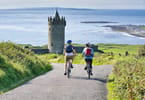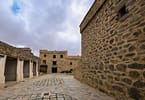TANZANIA (eTN) – Provisional voting of Table Mountain in South Africa in the list of New7Wonders of Nature and Mount Kilimanjaro in Tanzania among most attractive sites in Africa has been a blessing to Tanzanian tourist stakeholders, looking at more recognition of Africa as an upcoming tourist destination.
Tour operators in Tanzania are happy to see Mount Kilimanjaro appearing in the top list of the most unique, natural features loved by tourists. The Tanzania Tourist Board (TTB) has been happy to see Mount Kilimanjaro best placed among leading natural wonders in the world, which attracts hundreds of thousands of admirers every year.
A message from the Tourist Board’s top management said Mount Kilimanjaro had entered into a highly-contested position as one among 14 natural wonders in the world, making this famous and highest mountain in Africa more known across the world, while making it clear that it is located in Tanzania.
During the tough competition to get seven new natural wonders of the world, Mount Kilimanjaro and Table Mountain in South Africa were competing against each other, out of 28 other natural features nominated for electronic voting.
Provisional results released last Friday by the competition organizers, the New7Wonders, indicate that Table Mountain in South Africa scooped the lead to enter the list of New7Wonders of Nature early next year when the jury panel finalizes the voting exercise.
Both Table Mountain and Mount Kilimanjaro are tourism icons for the Southern African destination, under the Regional Tourism Organization of Southern Africa (RETOSA).
On the other hand, Tanzania Tourist Board management expressed its appreciation and thanked all voters who made it possible for Mount Kilimanjaro to make it to the 14th position among the most attractive natural features of the world. The Board’s management, however, acknowledged all Tanzanians, government leaders, and several institutions within and outside for their commitment to vote the mountain into its current position.
“We thank all Tanzanians for patriotism during the voting exercise,” the Tourism Board’s message said.
The 28 official finalists have been chosen and announced by the New7Wonders panel of experts on July 21, 2009 under the leadership of Prof. Dr. Federico Mayor, former Director General of the United Nations Educational, Scientific, and Cultural Organization (UNESCO).
Criteria to get seven new natural wonders were based on the unique beauty of the nominated site, diversity and distribution (accounted for in 7 groups), ecological significance (in terms of either stand-alone eco-systems and/or their significance for human beings), historical legacy (relation that human beings and/or indigenous populations have or have had with the site), and geo-location of the site.
Covered in mist, full of legends and mystery, Mount Kilimanjaro, otherwise known as the roof of Africa, stands to attract tourists from all corners of the world.
Shrouded in gray, dark clouds and covered in mist most of the day, Mount Kilimanjaro with a height of 5,895 meters is located some 330 kilometers south of the equator, giving an awesome and magnificent inspiration hundreds of miles away.
Kilimanjaro is one of the leading single and free-standing mountains in the world, and it is composed of three independent peaks of Kibo, Mawenzi, and Shira. The entire mountain area takes up 4,000 kilometers of the Earth’s surface.
Formed some 750,000 years ago through volcanic eruptions, Mount Kilimanjaro took on several geological changes for 250,000 years, and the present features were formed during the past 500,000 years after a number of upheavals and tremors took place to cause the formation of 250 volcanic hills and crater lakes including the magnificent Lake Chala down its slopes.
The last volcanic activity occurred about 200 years ago and created a symmetrical cone of ash around Kibo peak, and since then, Mt. Kilimanjaro was at peace until today, but people who were living on the slopes and observed volcanic eruptions connected this natural phenomenon to punishment from God.
While Mt. Kilimanjaro is Africa’s jewel today, earlier occupants of its slopes took this glorious and glamorous mountain as a place to not go for fear of reprisal from God, because it was His almighty seat. Locals today see the dwindling snow as a punishment from God because too many humans attempt to climb it every day. Tourist deaths on the mountain are, as well, connected to the wrath of God.
Uncounted stories, along with thousands of myths and legends are told about Mt. Kilimanjaro. Locals on the slopes, the Chagga people, tell of pygmies said to be no larger than human children who dwelt in the mountain’s caves and ravines. These ravines, which have never been explored by tourists or other people, are said to have been inhabited by mountain pygmies who survived by hunting and gathering.
Stories of Mt. Kilimanjaro tell of mountain gorillas that once lived inside the dense, rainforest surrounding its slopes many years ago. Tales from the locals, though no scientific data is yet available to ascertain this, have occupied the minds of tourists climbing the mountain today.
Folklores dominate Mt. Kilimanjaro as well. The awesome feature of the mountain with the snow on its peak has attracted locals to connect the mountain with the heavens, believing that it was the seat of God, glorified by the whitish color of the snow.
During dry seasons in the past, locals blamed the mountain’s demons for taking away the rain, but when the rain was too much, they turned their faces to the mountain, bowing, asking God to forgive them.
Adding to the mystery of this highest mountain, there are probably dozens of names connected with it, which remains a puzzle today.
For the local Chaggas, the name Kilimanjaro does not belong with their history or legend. This does not mean much to them, although it’s the most famous name to foreign visitors or others from far away. The Chaggas don’t have a collective name for this majestic mountain, they have two separate names. They call the highest peak “Kipoo” or Kibo and the shortest peak “Kimawense” or Mawenzi.
The Maasai people on the very lower slopes never gave a name to this awe-inspiring mountain but the “Wakamba” people on the Kenyan side named it “Kilima Jeu” and “Kayolaa.”
Germans named it “Kilimandscharos,” and nobody knows for sure where the Germans got this name. Some people think it could have been born from a wrong pronouncement from the Chagga’s expression “Kilemeiroiya,” meaning “not easy to climb on,” when the early Germans wanted to climb the mountain.
It is also believed that the present name of the mountain was derived from the Swahili people from Mombasa and other coastal towns who called it “Kilima Njaro,” or mountain of caravans, because they used the mountain as their compass to determine directions from far away.
Other communities like the Kikuyu and Maasai have their interpretations of what the mountain’s name means and how it came about. Some historians also feel that outsiders may have changed the Chagga word to “Kilema kyaro,” which means “difficult journey to Kilimanjaro.” Another theory is that the travelers to the mountain may have asked the Maasai living on the plains what they called the mountain, and the Maasai may have answered that it was the source of water using the word “Ngare,” which then evolved to “Njare” or “Njaro.”
Other writers have since suggested that the name means “Shining Mountain,” “White Mountain,” or “Mountain of Water.”
Kilimanjaro, unlike other known mountains in the world, has its present name remain a puzzle to this date. Tourists and other mountain lovers could one day solve this puzzle. Its name remains one of many popular myths that add to its attraction for those wishing to unravel it.
Although mentioned in African legends, the earliest written records of the mountain date back to the second century when a Greek geographer, Ptolemy, from Alexandria in Egypt, wrote about the land beyond “Opone” and the great snow mountain in Rhapta. Opone, according to Ptolemy, is the coastal part of Somalia and northern coast of Kenya, and Rhapta is the big land mass, or the great East African massif, where Mt. Kilimanjaro is part of this huge land area.
Mt. Kilimanjaro had been thought to be the source of the River Nile and a mountain of mystery – the mystery being a snow-capped mountain in Africa. Africa was thought to be a continent of savages, thus stories about the continent were often down played. With colonization, came European missionaries who traveled inland to preach their religion.
1n 1846, Dr. Ludwig Krapf and Johann Rebmann landed at the coast of Kenya and set up a missionary at Rabai, close to the town of Mombasa. In 1849, both Krapf and Rebmann confirmed their sightings of the great mountain. Rebmann saw the mountain from his camp at Taveta in Kenya.
Reports about the mountain were received by the Royal Geographical Society, which prompted a great debate about the accuracy of its height and the possibility of snow-capped mountains in Africa.
In 1861, Richard Thornton attempted the first climb. The mountain was new to him, and he had a difficult time penetrating through the second zone. The weather was also bad, which forced him back down the mountain. In 1862, Otto Kersten and Baron Von der Decken attempted the climb. They climbed over 15,000 feet but were also forced down because of bad weather.
On October 5, 1889, a German geologist succeeded to reach the Kibo peak, the highest point on the African continent. He named this loftiest spot in Africa after himself, of course – Kaiser Wilhelm’s Peak.
Prominent and world personalities have climbed the mountain, including former United States Secretary of Interior Stuart Udall in 1963, and former US President Jimmy Carter in 1988, among other dignitaries.
Retired Tanzanian army General Mirisho Sarakikya is the known Tanzanian to have climbed the mountain 38 times in his annual pilgrimage to the roof-top of Africa. The General saw this majestic mountain as the only natural laboratory and as therapy for unknown diseases.
“If you manage to reach its peak, then be assured of your body fitness – you are physically fit. When you have a health problem, the climbing exercise will detect it, and you will not reach the top point,” the General said.
The oldest Mt. Kilimanjaro climber known today is an 84-year-old American tourist, Mr. Richard Byerley from Washington state, who recently broke the record to become the oldest person to reach the peak of Mt. Kilimanjaro. Byerley had his name entered into the Guinness Book of World Records as the oldest known climber to reach the highest peak on the African continent.
Mt. Kilimanjaro represents the world-wide image of Africa, and its towering, snow-capped symmetrical cone is synonymous with Africa. Internationally, the challenge of learning about, exploring, and climbing this mysterious mountain has captured the imagination of people throughout the world. To many, the chance to climb this mountain is an adventure of a lifetime.
Until today, Mt. Kilimanjaro has been a symbol of various national and international activities, business, and even politics. Business companies and various social clubs have their registrations bearing Mount Kilimanjaro’s name to portray their majestic existence.
In 1961, the flag of the newly-independent Tanzania was carried up the mountain to be flown on top of the mountain, and the freedom torch was lighted on the peak to stir up a political campaign for unity, freedom, and fraternity.
Tanzania will mark 50 years of independence next month with the symbol and pride of Mt. Kilimanjaro as its tourist, social, and political brand mark. This is why the mountain qualified to fulfill criteria to enter the recent competition to enter the list of the New7Wonders of Nature.
WHAT TO TAKE AWAY FROM THIS ARTICLE:
- Provisional voting of Table Mountain in South Africa in the list of New7Wonders of Nature and Mount Kilimanjaro in Tanzania among most attractive sites in Africa has been a blessing to Tanzanian tourist stakeholders, looking at more recognition of Africa as an upcoming tourist destination.
- A message from the Tourist Board’s top management said Mount Kilimanjaro had entered into a highly-contested position as one among 14 natural wonders in the world, making this famous and highest mountain in Africa more known across the world, while making it clear that it is located in Tanzania.
- Criteria to get seven new natural wonders were based on the unique beauty of the nominated site, diversity and distribution (accounted for in 7 groups), ecological significance (in terms of either stand-alone eco-systems and/or their significance for human beings), historical legacy (relation that human beings and/or indigenous populations have or have had with the site), and geo-location of the site.






















